Citroen DS3 2011 1.G Owner's Guide
Manufacturer: CITROEN, Model Year: 2011, Model line: DS3, Model: Citroen DS3 2011 1.GPages: 324, PDF Size: 25.11 MB
Page 21 of 324
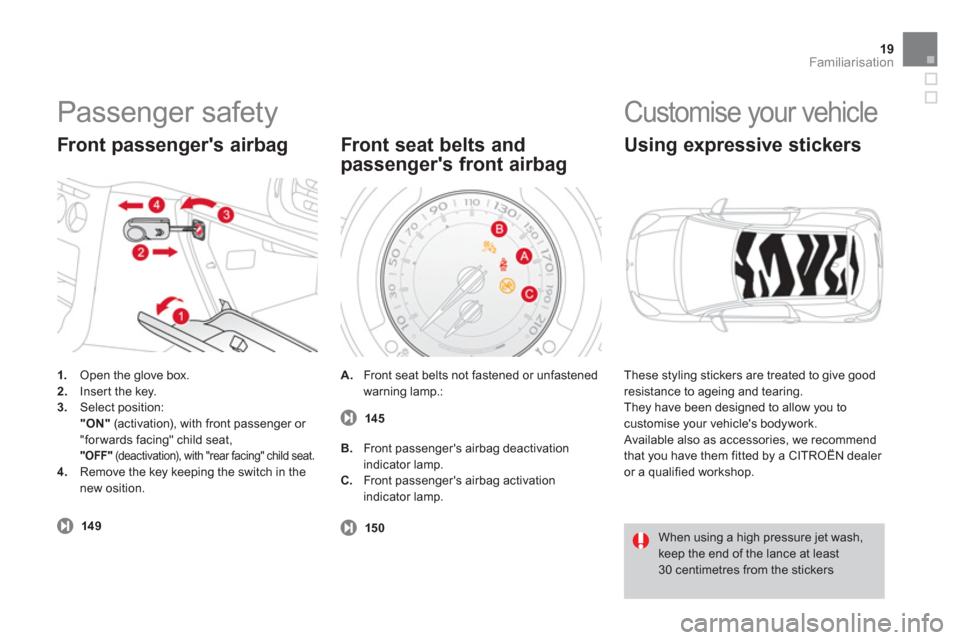
19Familiarisation
Passenger safety
1.
Open the glove box.
2.
Inser t the key.
3.
Select position:
"ON"
(activation), with front passenger or
"for wards facing" child seat,
"OFF"
(deactivation), with "rear facing" child seat.
4.
Remove the key keeping the switch in the
new osition.
Front passenger's airbag
14 9
A.
Front seat belts not fastened or unfastened
warning lamp.:
Front seat belts and
passenger's front airbag
15 0
Customise your vehicle
These styling stickers are treated to give good
resistance to ageing and tearing.
They have been designed to allow you to
customise your vehicle's bodywork.
Available also as accessories, we recommend
that you have them fitted by a CITROËN dealer
or a qualified workshop.
Using expressive stickers
When using a high pressure jet wash,
keep the end of the lance at least
30 centimetres from the stickers
B.
Front passenger's airbag deactivation
indicator lamp.
C.
Front passenger's airbag activation
indicator lamp. 14 5
Page 22 of 324
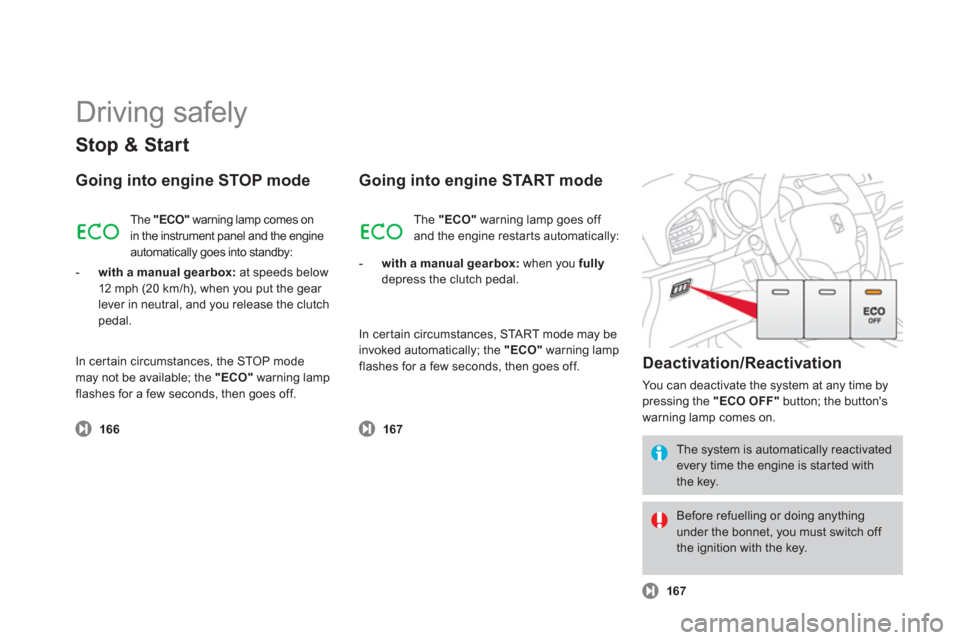
Driving safely
Stop & Start
Going into engine STOP mode
166
The "ECO"
warning lamp comes on
in the instrument panel and the engine
automatically goes into standby:
- with a manual gearbox:
at speeds below
12 mph (20 km/h), when you put the gear
lever in neutral, and you release the clutch
pedal.
Going into engine START mode
Deactivation/Reactivation
You can deactivate the system at any time by
pressing the "ECO OFF"
button; the button's
warning lamp comes on.
167
167
The system is automatically reactivated
every time the engine is star ted with
the key.
Before refuelling or doing anything
under the bonnet, you must switch off
the ignition with the key. The "ECO"
warning lamp goes off
and the engine restarts automatically:
- with a manual gearbox:
when you fully
depress the clutch pedal.
In certain circumstances, the STOP mode
may not be available; the "ECO"
warning lamp
flashes for a few seconds, then goes off. In certain circumstances, START mode may be
invoked automatically; the "ECO"
warning lamp
flashes for a few seconds, then goes off.
Page 23 of 324
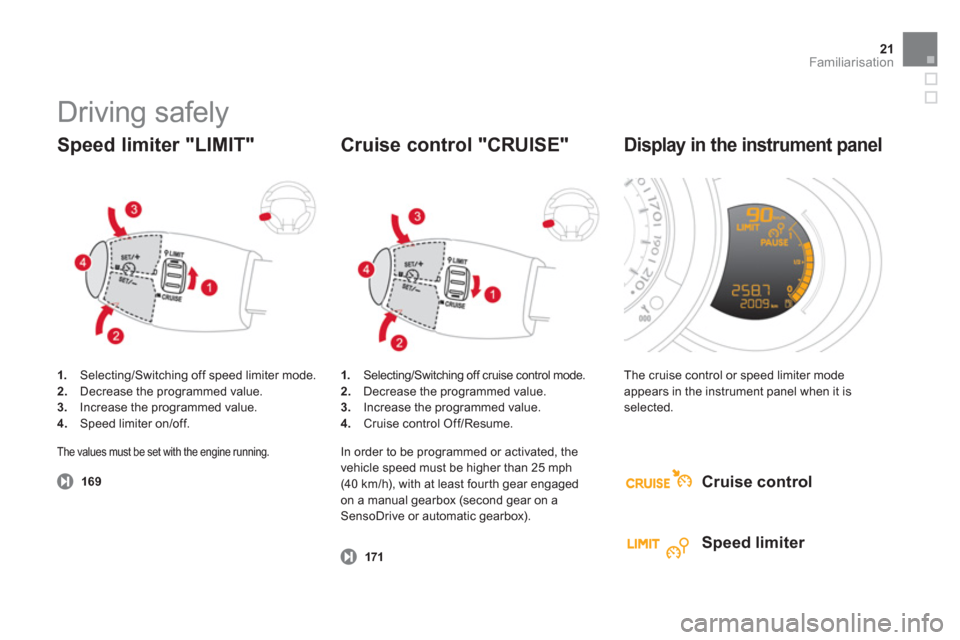
21Familiarisation
Driving safely
1.
Selecting/Switching off speed limiter mode.
2.
Decrease the programmed value.
3.
Increase the programmed value.
4.
Speed limiter on/off.
Speed limiter "LIMIT"
169
1.
Selecting/Switching off cruise control mode.
2.
Decrease the programmed value.
3.
Increase the programmed value.
4.
Cruise control Off/Resume.
Cruise control "CRUISE"
171
The cruise control or speed limiter mode
appears in the instrument panel when it is
selected.
Display in the instrument panel
Cruise control
Speed limiter
The values must be set with the engine running.
In order to be programmed or activated, the
vehicle speed must be higher than 25 mph
(40 km/h), with at least four th gear engaged
on a manual gearbox (second gear on a
SensoDrive or automatic gearbox).
Page 24 of 324
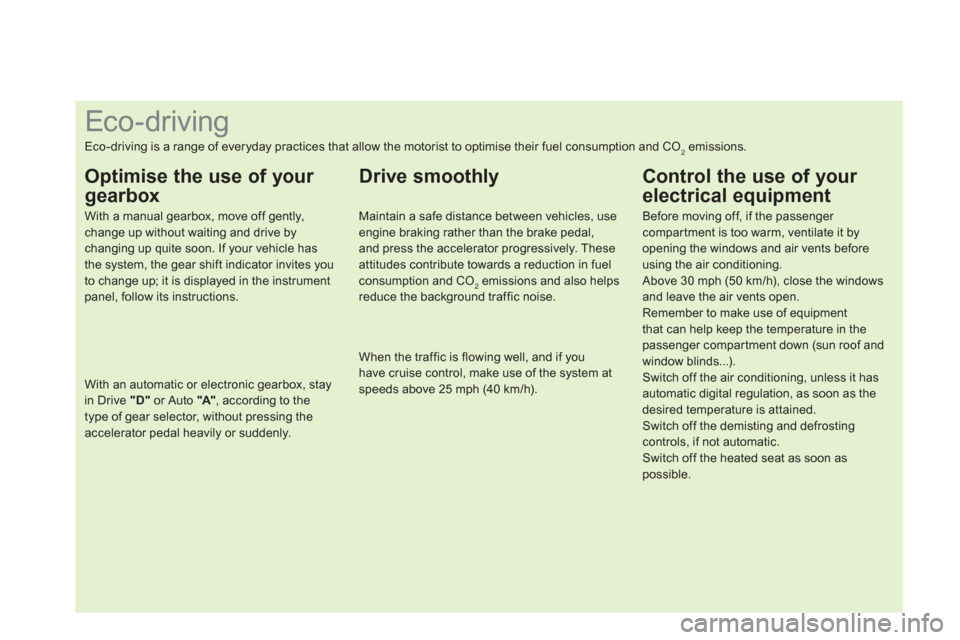
Eco-driving
Eco-driving is a range of everyday practices that allow the motorist to optimise their fuel consumption and CO2 emissions.
Optimise the use of your
gearbox
With a manual gearbox, move off gently,
change up without waiting and drive by
changing up quite soon. If your vehicle has
the system, the gear shift indicator invites you
to change up; it is displayed in the instrument
panel, follow its instructions.
With an automatic or electronic gearbox, stay
in Drive "D"
or Auto "A"
, according to the
type of gear selector, without pressing the
accelerator pedal heavily or suddenly.
Drive smoothly
Maintain a safe distance between vehicles, use
engine braking rather than the brake pedal,
and press the accelerator progressively. These
attitudes contribute towards a reduction in fuel
consumption and CO
2 emissions and also helps
reduce the background traffic noise.
When the traffic is flowing well, and if you
have cruise control, make use of the system at
speeds above 25 mph (40 km/h).
Control the use of your
electrical equipment
Before moving off, if the passenger
compartment is too warm, ventilate it by
opening the windows and air vents before
using the air conditioning.
Above 30 mph (50 km/h), close the windows
and leave the air vents open.
Remember to make use of equipment
that can help keep the temperature in the
passenger compar tment down (sun roof and
window blinds...).
Switch off the air conditioning, unless it has
automatic digital regulation, as soon as the
desired temperature is attained.
Switch off the demisting and defrosting
controls, if not automatic.
Switch off the heated seat as soon as
possible.
Page 25 of 324
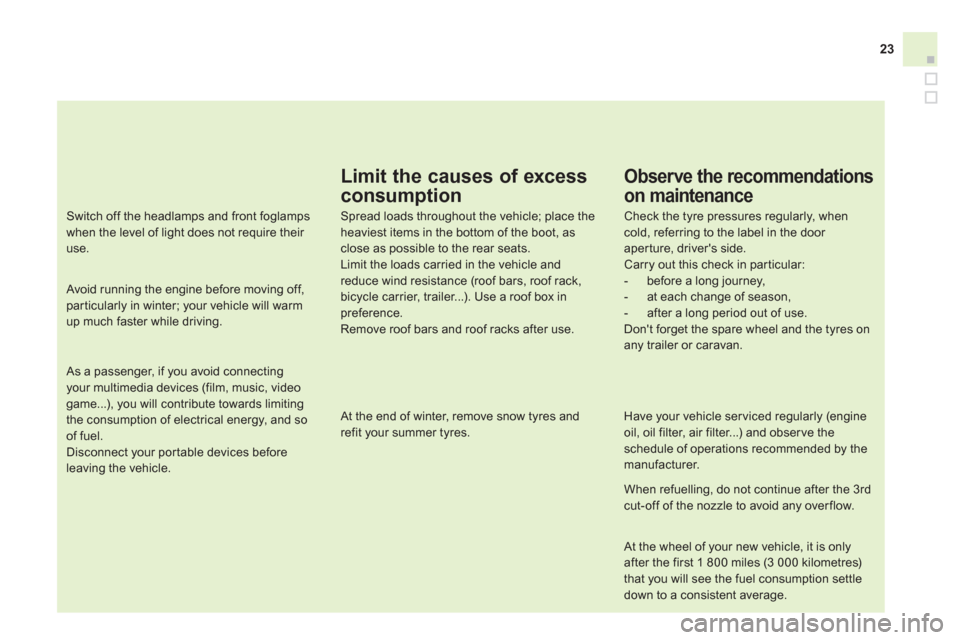
23
Limit the causes of excess
consumption
Spread loads throughout the vehicle; place the
heaviest items in the bottom of the boot, as
close as possible to the rear seats.
Limit the loads carried in the vehicle and
reduce wind resistance (roof bars, roof rack,
bicycle carrier, trailer...). Use a roof box in
preference.
Remove roof bars and roof racks after use.
At the end of winter, remove snow tyres and
refit your summer tyres.
Observe the recommendations
on maintenance
Check the tyre pressures regularly, when
cold, referring to the label in the door
aperture, driver's side.
Carry out this check in par ticular:
- before a long journey,
- at each change of season,
- after a long period out of use.
Don't forget the spare wheel and the tyres on
any trailer or caravan.
Have your vehicle ser viced regularly (engine
oil, oil filter, air filter...) and obser ve the
schedule of operations recommended by the
manufacturer.
When refuelling, do not continue after the 3 rd
cut-off of the nozzle to avoid any over flow.
At the wheel of your new vehicle, it is only
after the first 1 800 miles (3 000 kilometres)
that you will see the fuel consumption settle
down to a consistent average.
Switch off the headlamps and front foglamps
when the level of light does not require their
use.
Avoid running the engine before moving off,
particularly in winter; your vehicle will warm
up much faster while driving.
As a passenger, if you avoid connecting
your multimedia devices (film, music, video
game...), you will contribute towards limiting
the consumption of electrical energy, and so
of fuel.
Disconnect your portable devices before
leaving the vehicle.
Page 26 of 324
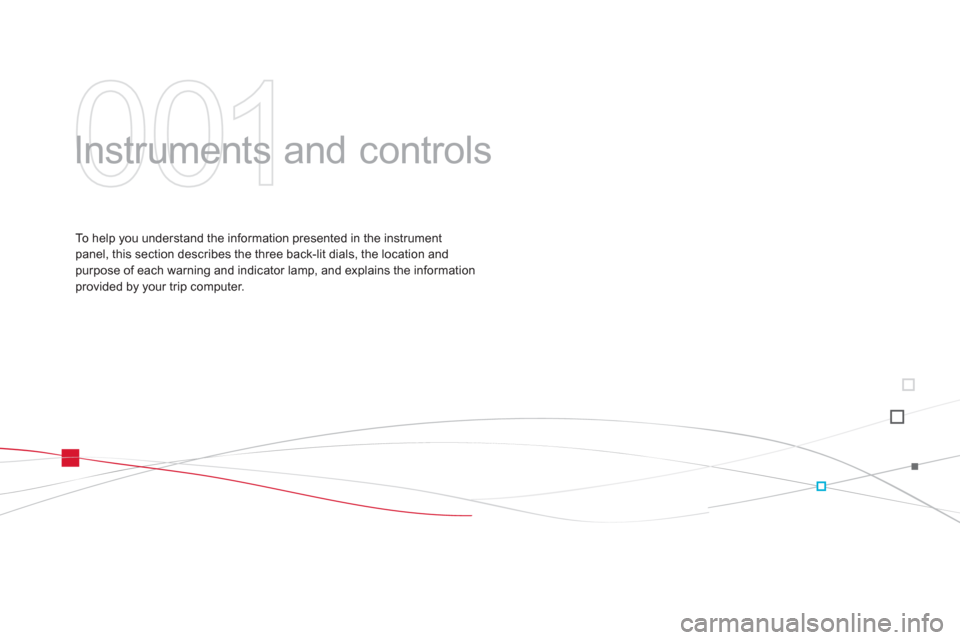
001
Instruments and controls
To help you understand the information presented in the instrument
panel, this section describes the three back-lit dials, the location and
purpose of each warning and indicator lamp, and explains the information
provided by your trip computer.
Page 27 of 324
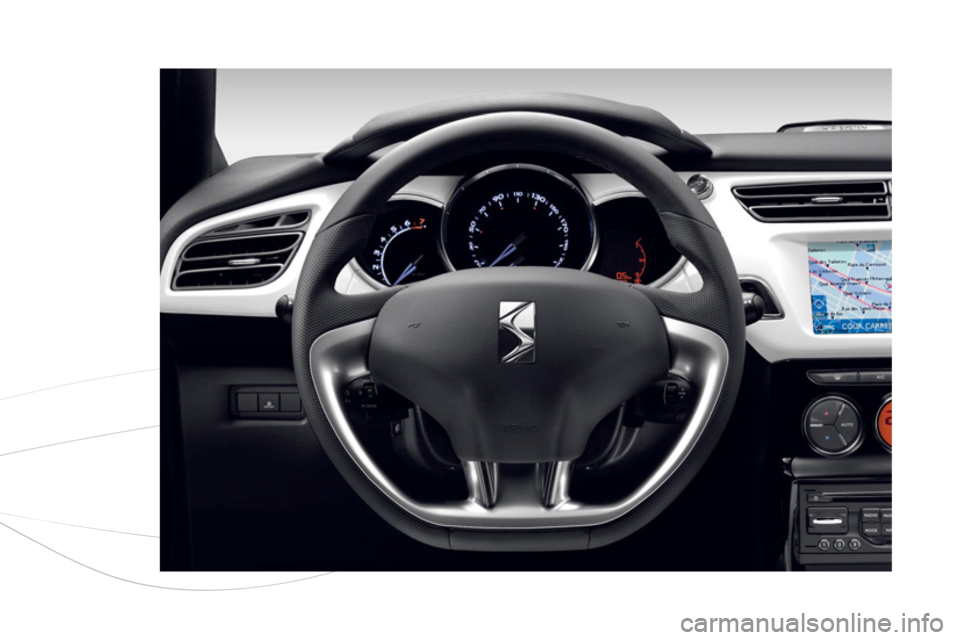
Page 28 of 324
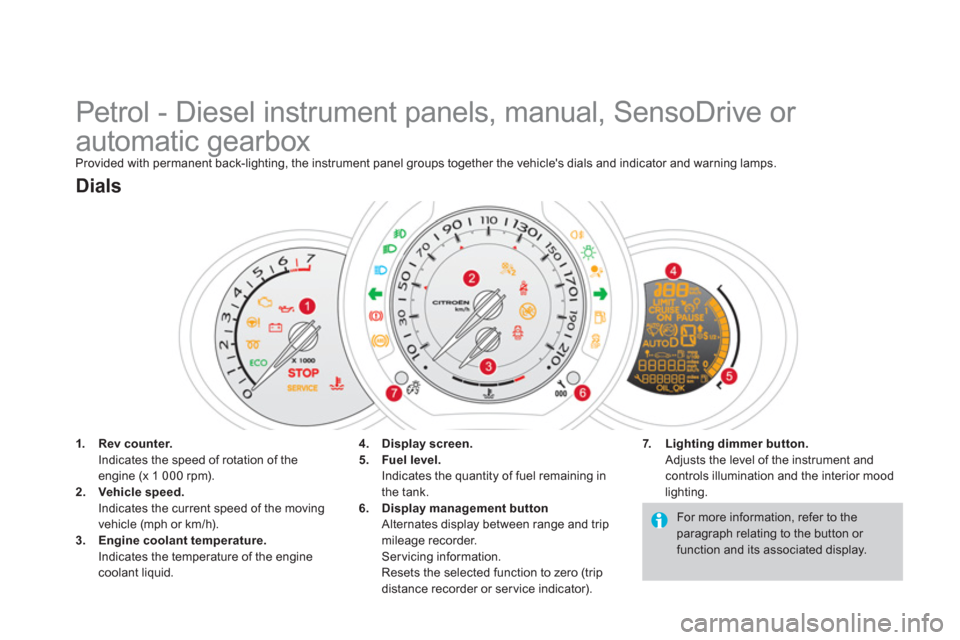
Petrol - Diesel instrument panels, manual, SensoDrive or
automatic gearbox
Provided with permanent back-lighting, the instrument panel groups together the vehicle's dials and indicator and warning lamps.
1.
Rev counter.
Indicates the speed of rotation of the
engine (x 1 000 rpm).
2.
Vehicle speed.
Indicates the current speed of the moving
vehicle (mph or km/h).
3.
Engine coolant temperature.
Indicates the temperature of the engine
coolant liquid.
Dials
7.
Lighting dimmer button.
Adjusts the level of the instrument and
controls illumination and the interior mood
lighting.
4.
Display screen.
5.
Fuel level.
Indicates the quantity of fuel remaining in
the tank.
6.
Display management button
Alternates display between range and trip
mileage recorder.
Servicing information.
Resets the selected function to zero (trip
distance recorder or ser vice indicator). For more information, refer to the
paragraph relating to the button or
function and its associated display.
Page 29 of 324
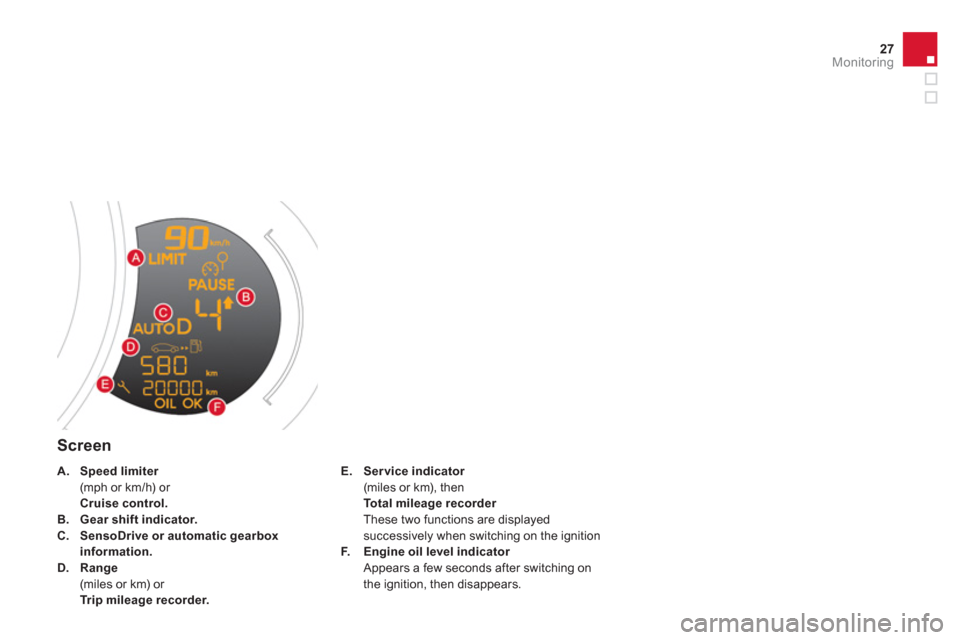
27Monitoring
Screen
E.
Ser vice indicator
(miles or km), then
Total mileage recorder
These two functions are displayed
successively when switching on the ignition
F.
Engine oil level indicator
Appears a few seconds after switching on
the ignition, then disappears.
A.
Speed limiter
(mph or km/h) or
Cruise control.
B.
Gear shift indicator.
C.
SensoDrive
or automatic gearbox
information.
D.
Range
(miles or km) or
Trip mileage recorder.
Page 30 of 324
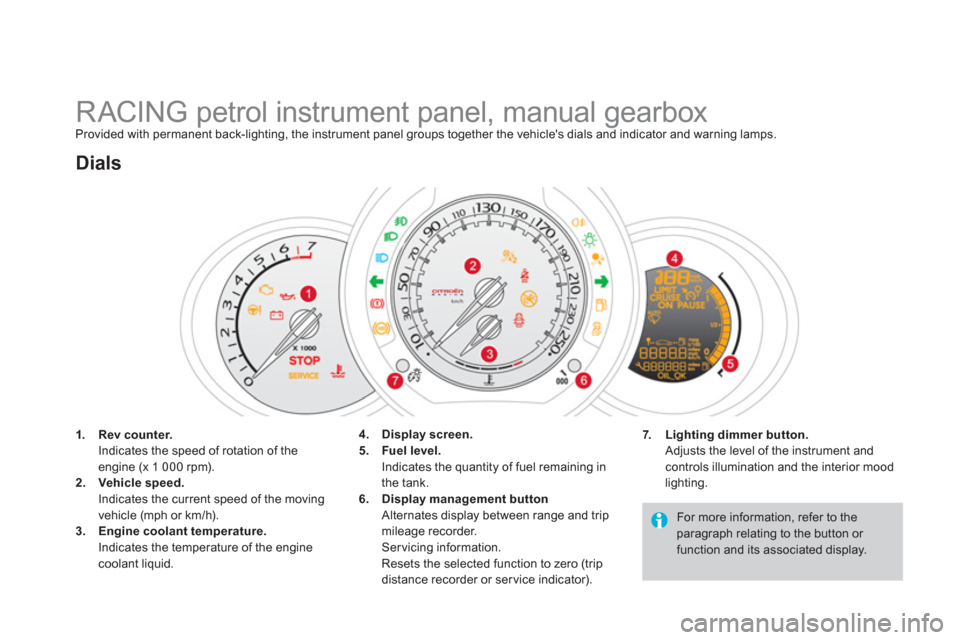
RACING petrol instrument panel, manual gearbox
Provided with permanent back-lighting, the instrument panel groups together the vehicle's dials and indicator and warning lamps.
1.
Rev counter.
Indicates the speed of rotation of the
engine (x 1 000 rpm).
2.
Vehicle speed.
Indicates the current speed of the moving
vehicle (mph or km/h).
3.
Engine coolant temperature.
Indicates the temperature of the engine
coolant liquid.
Dials
7.
Lighting dimmer button.
Adjusts the level of the instrument and
controls illumination and the interior mood
lighting.
4.
Display screen.
5.
Fuel level.
Indicates the quantity of fuel remaining in
the tank.
6.
Display management button
Alternates display between range and trip
mileage recorder.
Servicing information.
Resets the selected function to zero (trip
distance recorder or ser vice indicator). For more information, refer to the
paragraph relating to the button or
function and its associated display.